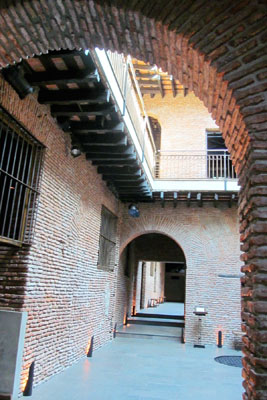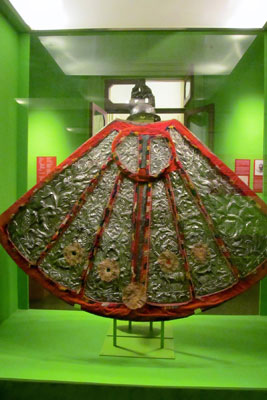El Zanjón in Buenos Aires
This item appears on page 55 of the July 2015 issue.
Buenos Aires, Argentina, is a city of many faces. Among them is the brash neighborhood called La Boca, with the tourist-filled, colorful promenade El Caminito; the upscale section called Recoleta, centered on the mausoleum-laden cemetery where Evita Perón lies buried in a much-visited tomb; the Palermo neighborhood, with its many parks, restaurants and tall apartment buildings, and the old neighborhood of San Telmo, a mix of picturesque dilapidated houses and those now in the process of restoration.
It is in San Telmo that visitors can see an impressive architectural relic from the city’s past: El Zanjón de Granados.
San Telmo is one of Buenos Aires’ oldest neighborhoods. Until the middle of the 19th century, it was where those with money lived. Yellow fever struck in 1871, driving many of San Telmo’s residents to other parts of the city.
After this epidemic, newcomers moved in, wave after wave of European immigrants. They crowded into the abandoned mansions. Often, one large dwelling became home to dozens of immigrant families. The once-grand houses became tenements called conventillos, which gradually deteriorated, leaving only vestiges of what they once were — an elaborate wrought-iron balcony here, ornate stone carvings there.
One such conventillo/mansion is El Zanjón de Granados, located at 755 Calle Defensa in the heart of San Telmo.
History of a house
The first settlement of 16th-century Buenos Aires was probably not far from where El Zanjón is now located.
According to a 1580 map, at the confluence of two streams — one of which was called El Zanjón de Granados — Juan González built a dwelling that stands where the house called El Zanjón is today. A remnant of wall from that house still exists.
This dwelling was replaced in 1740 by Miguel de Arce, who added a lookout tower that still stands.
In 1830, the Miguens family replaced this with a mansion built around three patios to house themselves and their six slaves. After the 1871 yellow fever epidemic, this mansion was divided up into apartments for immigrant families. There was a general store, a wine shop and a cobbler on the ground floor, with tenants living on the floors above.
By 1985 this building was abandoned. It was full of rubble, with trees growing in the patios and weeds growing out of the façade. It looked destined for demolition. Luckily, El Zanjón was rescued by Jorge Eckstein, an Argentinian chemical engineer, who bought it, spent over 20 years restoring it and opened it to the public as a private museum.
Result of excavations
Eckstein’s was a painstaking, ambitious project that has been called the most important urban archaeological project in Buenos Aires.
In the process of excavation, almost five centuries of urban living was unearthed — house foundations and walls, floors, septic tanks, wells and, most interesting of all, the now-dried-up stream bed, now encased in beautifully reconstructed vaulted brick tunnels.
Since the stream had been a dump in the days before sewers, numerous artifacts from all eras of the house’s history were also found: French tiles, English china, African pipes and locally made pottery.
El Zanjón de Granados (Defensa 755, San Telmo, Buenos Aires, Argentina; phone 011 [54 11] 4361 3002, email turismo@elzanjon.com.ar or visit www.elzanjon.com.ar) can be visited by tour only. Reservations are not necessary (but I would call in advance anyway).
Tours last 60 minutes, cost 120 pesos (about $13.50) and are given on the hour from 11 to 3, Monday to Friday. Thirty-minute tours are offered on Sunday from 1 to 6; these tours cost 75 pesos.
Ethnographic museum
A 15-minute walk from El Zanjón, the Juan B. Ambrosetti Museo Etnográfico (350 Calle Moreno, San Telmo, Buenos Aires, Argentina; phone 54 11 4345 8196, email info.museo@filo.uba.ar or visit museo etnografico.filo.uba.ar) is worth a quick visit if only to see the two cloaks covered with incised silver plaques on display. These cloaks were once worn by indigenous dancers in Bolivia during religious processions.
Indigenous items from northwestern Argentina — the main reason my husband, Paul, and I visited — are also supposedly on display, but the room where they are kept was closed when we arrived (no explanation).
The museum is open 1 to 7 Tuesday to Friday and 3 to 7 Saturday and Sunday. There is no admission charge, but 20 pesos (about $2.25) per person is requested as a donation.
If you go…
We spent five weeks in Buenos Aires in July-August 2014. We rented an apartment in Recoleta, an upscale section of the city, through an excellent company, ByT Argentina (phone 011 54 11 4876 5000, email info@bytargentina.com or visit bytargentina.com), which offers over 2,000 rental properties throughout the city.
Our favorite area of Buenos Aires has always been Recoleta. It’s safe. It’s elegant. It’s wonderful to stroll there. Recoleta Cemetery, with its thousands of ornate mausoleums, is located there, as is one of Buenos Aires’ most renowned cafés, La Biela. Both cemetery and café were a 10-minute walk from our apartment.
The apartment we rented was on Calle Posadas, just around the corner from one of South America’s best and most famous hotels, the Alvear Palace Hotel. (In fact, we could enter our rental building, if we wanted, through the shopping arcade of the Alvear.)
Our penthouse apartment had an elegant, split-level living/dining room, a kitchen with dishwasher and washing machine, three bedrooms, 2½ bathrooms and a large terrace filled with plants and with a fantastic view over Buenos Aires, especially at night.
At the time we rented, the monthly rental was $2,625, an incredible $90 per night to live like the idle rich we’ve always wanted to be.


